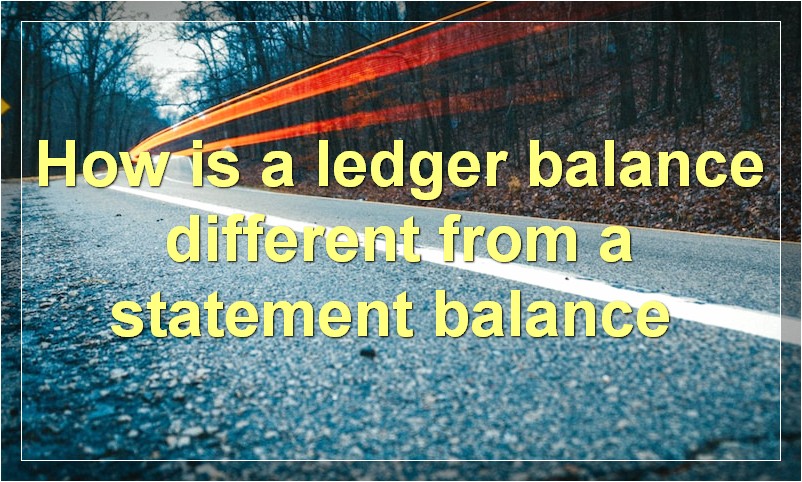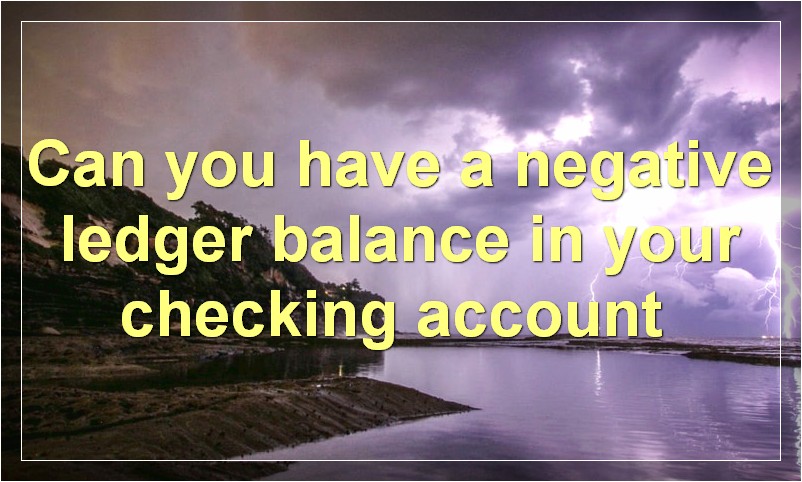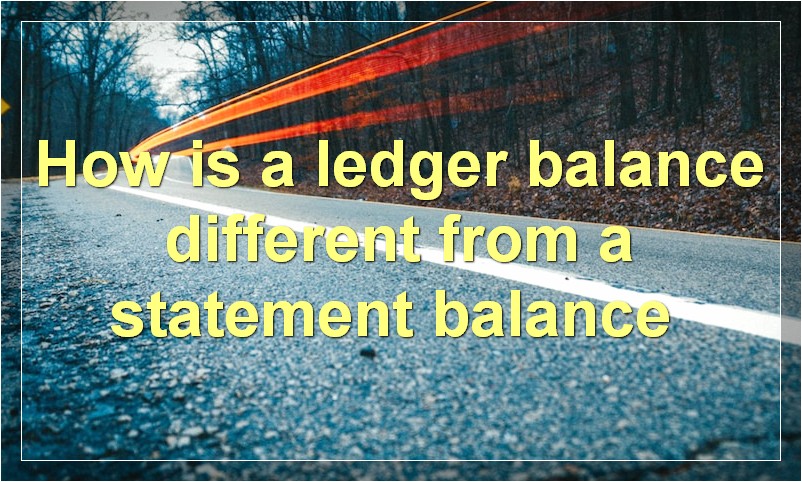If you’re like most people, the term “ledger balance” probably doesn’t mean much to you. But if you have a bank account, it’s important to know what it is and how it affects you.
What is a ledger balance?
A ledger balance is the balance in a ledger account. A ledger account is an account in a general ledger that is used to store information about a specific aspect of a business’s finances. The ledger balance is the sum of all the debits and credits in the account.
How is a ledger balance different from a statement balance?

A ledger balance is different from a statement balance in a few key ways. First, a ledger balance includes all transactions that have been posted to the account, regardless of whether or not they have appeared on a statement. This means that if you made a payment on the 1st of the month, but your statement doesn’t close until the 10th, that payment would still be included in the ledger balance.
Second, a statement balance only includes transactions that have posted to the account up to the statement date. So, if your statement closes on the 10th of the month, any transactions made on the 11th (and beyond) wouldn’t be included. This is why it’s important to keep track of your account activity and make sure there aren’t any surprises when your statement comes.
Lastly, a ledger balance may also include unpaid fees or interest charges, while a statement balance will never include these charges. This is because fees and interest typically post after the statement date, so they’ll appear on the next month’s statement.
All in all, a ledger balance provides a more accurate picture of your account activity and what your current balance actually is. So, if you’re ever wondering why your ledger balance is different from your statement balance, now you know!
Why is it important to know your ledger balance?
Most people understand that it is important to know how much money is in their checking account so they do not overdraft. However, many people do not realize how important it is to also keep track of their ledger balance. A ledger balance is the ending balance in your checkbook after you have taken into account all deposits and withdrawals, including any outstanding checks or debit card transactions.
Your ledger balance may be different than your checking account balance at the bank for a number of reasons. For example, if you wrote a check for $100 but do not have enough money in your account to cover it, your ledger balance would be -$100. In this case, even though the check has not cleared yet, you are still responsible for that amount of money.
Similarly, if you used your debit card to make a purchase but the transaction has not cleared yet, your ledger balance would reflect that purchase immediately. However, your checking account balance at the bank would not change until the transaction goes through, which could be a few days later.
It is important to know your ledger balance so you can avoid bouncing checks or being charged overdraft fees. If you are ever in doubt about your balance, it is always best to err on the side of caution and assume that any outstanding checks or debit card transactions have gone through. This way, you will never be surprised by an unexpectedly low balance.
How can you find your ledger balance?
Most people don’t know their ledger balance. A ledger balance is the sum of all the money you have in your account, including any interest that has been earned but not yet paid out. It’s different from your account balance, which is the amount of money available to you at any given time.
Your ledger balance is important because it’s the basis for calculating many of the fees charged by your bank. For example, if you have a $1,000 balance in your checking account and write a check for $500, your available balance will drop to $500, but your ledger balance will remain at $1,000. If your bank charges a monthly maintenance fee of $10 per month on accounts with balances below $1,000, you’ll be charged that fee even though you only had $500 available to spend.
To find your ledger balance, look at your most recent bank statement. Your ledger balance is typically listed at the top of the page, above your account activity for the statement period.
If you can’t find your ledger balance on your statement, give your bank a call. A customer service representative should be able to tell you what your ledger balance is and how to find it in future statements.
What happens if your ledger balance is negative?
When you have a negative ledger balance, it means that you owe your bank money. This can happen for a number of reasons, including writing bad checks, having automatic payments come out of your account that you can’t cover, or making withdrawals from an ATM that exceed the amount of money you have in your account. If your ledger balance is negative, your first course of action should be to bring it back into the black by depositing money into your account. You may also want to contact your bank to see if they can provide you with any options for covering the negative balance, such as a short-term loan.
Can you have a negative ledger balance in your checking account?

Yes, you can have a negative ledger balance in your checking account. This happens when the account holder has more money owed to them than what is in the account. The account holder may have written too many checks or made too many withdrawals from the account. If this happens, the account holder will need to bring the account back into positive balance by depositing money into the account.
How do you reconcile a ledger balance with a statement balance?
When you reconcile your ledger with your statement, you are making sure that the two records match up. This can be done by comparing the ending balance on your ledger with the ending balance on your statement. If the two balances match, then you have successfully reconciled your accounts.
If the two balances do not match, there are a few things you can do to try and figure out where the discrepancy is coming from. First, you can check to see if there are any outstanding transactions that have not yet been recorded in your ledger. Secondly, you can look for any mistakes that may have been made in recording transactions in either your ledger or your statement. Finally, if you cannot find the source of the discrepancy, you may need to contact your bank or financial institution for help.
Reconciling your accounts on a regular basis is an important part of keeping accurate financial records. By taking the time to reconcile your ledger with your statement, you can ensure that your records are accurate and up-to-date.
What causes discrepancies between ledger balances and statement balances?
Discrepancies between ledger and statement balances can be caused by a number of factors, including timing differences, errors, or omissions. Timing differences can occur when transactions are recorded in the ledger but not reflected on the statement. This can happen when checks are mailed but not yet received, or when deposits are made but not yet processed. Errors can also cause discrepancies. For example, if a check is written for $100 but the ledger only shows $10, this will create a discrepancy. Omissions can also cause discrepancies. If a bank deposit is made but not entered into the ledger, this will create a discrepancy.
How do you bring your ledger balance back to zero?
When you’re first starting out with money management, it’s important to get into the habit of reconciling your accounts regularly. This means making sure that the transactions in your checkbook (or other personal records) match the official records of your bank or other financial institution. Once you’ve verified that everything matches up, you can move on to the next step: balancing your ledger.
The goal of balancing your ledger is to make sure that the total amount of money you have coming in (your income) is equal to the total amount of money you have going out (your expenses). This may seem like a daunting task, but it’s actually pretty straightforward once you get the hang of it.
There are two main methods you can use to balance your ledger: the trial and error method, and the account reconciliation method.
The trial and error method is the simpler of the two. To do this, you’ll need to add up all of your income for the month and all of your expenses for the month. Once you have those totals, subtract your expenses from your income. If the result is positive, that means you have money left over and you’re doing a good job of managing your finances. If the result is negative, that means you’re spending more than you’re bringing in and you need to take a closer look at your budget.
The account reconciliation method is a bit more complicated, but it’s also more accurate. To do this, you’ll need to get a copy of your most recent bank statement. Once you have that, compare it to your own records of what has been deposited into and withdrawn from your account. Any discrepancies between the two should be investigated until you can figure out where the mistake was made.
Once you’ve used one of these methods (or both) to bring your ledger back to zero, congratulations! You’ve just taken an important step in getting a handle on your finances.
Is there ever a time when you shouldn’t bring your ledger balance back to zero?
When it comes to managing your finances, there is no single “right” way to do things. Some people like to keep a close eye on their spending and make sure their bank balance always stays at zero. Others are more relaxed about their finances and don’t mind if their balance fluctuates a bit.
So, is there ever a time when you shouldn’t bring your ledger balance back to zero? Here are a few scenarios to consider:
1. When you have high-interest debt
If you have any high-interest debt, such as credit card debt, it’s important to focus on paying that off as quickly as possible. Making only the minimum payments on your credit cards will keep you in debt for a long time and end up costing you a lot of money in interest.
Instead of keeping your bank balance at zero, use any extra money you have to make extra payments on your debt. This will help you get out of debt faster and save money in the long run.
2. When you have upcoming expenses
If you know you have upcoming expenses, such as a car repair or a trip, it can be helpful to save up for those instead of keeping your balance at zero. This way, you won’t have to put these expenses on a credit card and rack up interest charges.
3. When you want to build up your emergency fund
It’s a good idea to have an emergency fund that you can tap into if you lose your job or have an unexpected expense. If you don’t have an emergency fund, now is the time to start one.
Keeping your balance at zero won’t help you build up your emergency fund quickly. Instead, it’s better to save up for this fund slowly over time so that you don’t have to worry about having enough money if something unexpected comes up.




